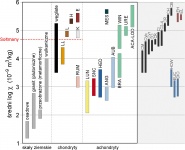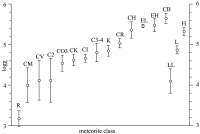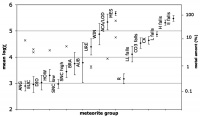O ile nie zaznaczono inaczej, prawa autorskie zamieszczonych materiałów należą do Jana Woreczko & Wadi.
(Unless otherwise stated, the copyright of the materials included belong to Jan Woreczko & Wadi.)
Szablon:Rochette (magnetic susceptibility, MaPS)
Z Wiki.Meteoritica.pl
1
Podstawowa literatura dotycząca podatności magnetycznej χ (ang. magnetic susceptibility) w zastosowaniu do klasyfikacji meteorytów kamiennych:
- Rochette Pierre, Sagnotti Leonardo, Bourot-Denise Michèle, Consolmagno Guy, Folco Luigi, Gattacceca Jérôme, Osete Maria Luisa, Pesonen Lauri, (2003), Magnetic classification of stony meteorites: 1. Ordinary chondrites, Meteoritics & Planetary Science, vol. 38(2), 2003, s. 251-268 (→ więcej).[1] Plik doi.
- Rochette Pierre, Gattacceca Jérôme, Bonal Lydie, Bourot-Denise Michèle, Chevrier Vincent, Clerc Jean-Pierre, Consolmagno Guy, Folco Luigi, Gounelle Matthieu, Kohout Tomas, Pesonen Lauri, Quirico Eric, Sagnotti Leonardo, Skripnik Anna, (2008), Magnetic classification of stony meteorites: 2. Non-ordinary chondrites, Meteoritics & Planetary Science, vol. 43(5), 2008, s. 959-980.[2] Plik doi.
- Rochette Pierre, Gattacceca Jérôme, Bourot-Denise Michèle, Consolmagno Guy, Folco Luigi, Kohout Tomas, Pesonen Lauri, Sagnotti Leonardo, (2009), Magnetic classification of stony meteorites: 3. Achondrites, Meteoritics & Planetary Science, vol. 44(3), 2009, s. 405-427.[3] Plik doi.
Rochette et al. 2009: Mean logχ (in 10−9 m3/kg) for the different studied achondrite groups, compared to selected chondrite groups. Meteorites excluded from the mean appear with crosses. Falls only are used for OC, CO3 and E (after Rochette et al. 2008). The metal amount (wt%) indicated is a maximum value, assuming non interacting multidomain spheres and not taking into account paramagnetic susceptibility |
Przypisy
Linki zewnętrzne
- Wikipedia – Podatność magnetyczna


